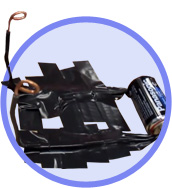Electric Motors
Overview
 After learning the basics of creating a circuit and electromagnetics, students design and create a simple electric motor. Students are encouraged to explore coil design, magnetic array, changing power sources, power sources.
After learning the basics of creating a circuit and electromagnetics, students design and create a simple electric motor. Students are encouraged to explore coil design, magnetic array, changing power sources, power sources.
Rationale (Why we are doing this?)
When students apply skills and understanding in a tangible, “hands-on” way, learning is enhanced, higher thinking skills are developed, and learning is fun.
Materials/Resources
Teacher supplies:
- Magnetic wire
- Regular household wire
- Sandpaper
- Some tools
- Electrician’s tape
Students supply:
- A small cardboard box with a lid (shoebox size or smaller
- 1 or 2 magnets of reasonable power (no fridge or horseshoe magnets) (Rona or Home Depot have excellent ones). I will show the students ones that work well.
- 1 or 2 “C” batteries (non-rechargeable)
- A pair of needlenose pliers are handy and are wire strippers (but not necessary). Please no multi-tools with a knife attachment.
Context and Background Knowledge
Student will have to have a basic safety lesson in how to use pliers, strip wire, and expectations. Remind students how to disconnect power is they get “hot spots”. A useful background knowledge builder is the Electricity sections of BC Science 6.
.
Curricular Connections (Competencies and Content)
| Devices that transform energy | (Science-4) |
| Energy: has various forms, is conserved | (Science-4) |
| Power- the rate at which energy is transformed | (Science-6) |
| Identify a design issue | (ADST-5) |
| Identify key features or user requirements | (ADST-5) |
| Identify the main objective for design and any constraints | (ADST-5) |
| Electricity – generated in different ways with different environmental impacts | (Science-7) |
| Electricity – used to generate magnetism | (Science-7) |
Design and Make the Motor
- Using a sample, students design their own motor (see sample or picture). It is useful to teach the names of the parts (coil, magnet array, posts, power source).
- Encourage students to test out variations on design (number of coils, setting up posts to reduce friction, improve balance). Encourage “guess and test,” prototyping skills, and testing multiple designs.
Applications/Adaptations/Extensions
- Provide students with switches, lights, small propellers, flags etc.
- Students can even experiment with sanding one side of the coil contact to create the difference between
